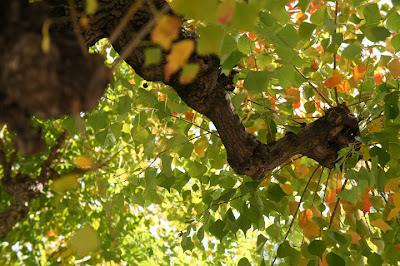My husband and I had a plan in our minds to go to Kyoto searching for some coloured maple leaves.
We wanted to go to mountainous area by train, but as the forecast said it would be going to rain, so we changed the destination and tried to stroll around more convenient area like a trip to nowhere.
We walked around the border between Nara and Kyoto where the altitude was a little higher than that of our residential area, expecting some colourful maple leaves by lower temperature.
As the forecast said the weather would be unstable, sometimes overcasting, sometimes sprinkling and when it had stopped abruptly the sun was out again.
Luckily enough we could see some shinning leaves for a while intermittently,
and when it started to rain again we took a rest in a small café with good coffee.
In Japan the saying 「女ごころと秋の空」,"A woman is a weathercock", is mentioned occasionally, but I wonder this unfair saying would be effectively said in English, too?
My husband actually said that I owed my opportunities for taking photos of the shining leaves to his good luck, while I was thinking about some abstraction of the world of leaves just before falling.
かえるでと呼ばるる青きときを過ぎ をりからの陽にもみぢ耀く
Maple leaves were young and
their greenness were so fluttery ,
and now they show their maturity
being irradiated
by transient sunlight
haricot
A ginkgo leaf is hanging on the maple bough...
............................... ☆..................................
I'd like to say thank you from my heart for all who have visited my blog.
And let me restart to do post when I will have read and learned more something suitable for blogging and have found some tanka which I 'd like to introduce you.
Thank you again, and I hope upcoming 2013 will be a happy year for you all.



















































